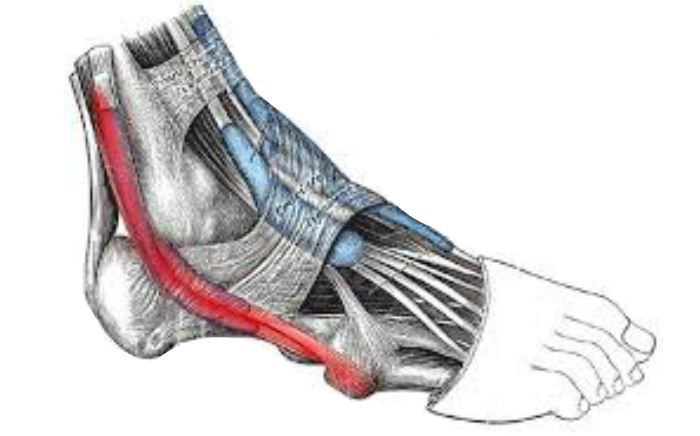What is Peroneal Tendonitis?
PERONEAL TENDONITIS
Peroneal tendonitis occurs when the peroneal tendons become inflamed. This happens when there is an increased load and overuse of the tendons, leading to them rubbing on the bone.
This friction causes the tendons to swell. Over time, the tendons will thicken in size to try and manage the increased load more efficiently.
Peroneal tendonitis is particularly common in athletes and especially runners, as they are more likely to make their feet roll outwards, causing friction between the tendon and bone.

What Causes Peroneal Tendonitis?
People who take part in a sport that involves repetitive ankle motion are most prone to peroneal tendonitis.
Factors that can contribute to peroneal tendonitis include:
- overuse
- a sudden increase in training, particularly weight-bearing activities, such as walking, running and jumping
- improper training techniques
- inadequate or unsupportive footwear
There are also some other issues that can increase a person’s risk of developing peroneal tendonitis:
- higher foot arches
- lower limb muscles and joints not working well together
- imbalanced muscles in the lower limbs
If someone fails to complete a rehabilitation program following an ankle injury, such as a sprain, they are also more likely to develop peroneal tendonitis.
Over time, the damaged peroneal tendons will thicken as scar tissue tries to repair the damaged area. This makes the tendons weaker and more prone to tearing.
Peroneal Tendonitis Diagnosis
To begin with, the doctor will discuss the person’s medical history with them. This will often point to overuse, increased activity, or some other cause of peroneal tendonitis.
It is important to determine that the pain is in the peroneal tendons and not the fibula, as this could indicate a different problem.
A physiotherapist or doctor will use a variety of techniques in a physical exam to look for symptoms, generally by moving the foot and ankle into different positions and applying pressure.
An X-ray, ultrasound, or MRI scan might also be used to rule out any breaks, identify abnormal swelling or scar tissue, and to further help with diagnosis.
Peroneal Treatment
Because the overuse of the tendons often causes peroneal tendonitis, rest is crucial to help them heal.
The individual should avoid walking or any other activities that may aggravate the injury until the pain has gone. The area needs time to recover and, in time, the pain will lessen.
Nonsurgical treatments that are common in cases of peroneal tendonitis include:
- Immobilization: Stopping the foot and ankle from moving using a boot or support.
- Medication: Anti-inflammatory drugs, such as ibuprofen, can help relieve pain and swelling.
- Physical therapy: Ice, heat, and ultrasound therapy can reduce pain and swelling. Once the symptoms improve, introduce exercises that strengthen the muscles and improve balance and motion.
- Bracing: Some people may require a brace for use during activities that involve repetitive ankle motion.
- Cortisone injection: In rare cases, doctors may recommend this powerful anti-inflammatory medication. However, if cortisone is injected into the peroneal tendons, there is a chance of rupture.
Surgery is rare when treating peroneal tendonitis, and it is only usually considered as a last resort if nonsurgical methods are not helping to reduce pain.
If the tissue around the tendons is causing irritation, the surgeon may undertake a procedure called tendon release to remove it.
If a tear has occurred because of the overuse of the peroneal tendons, the surgeon will also look to perform tendon repair.
Our Board Certified Podiatrists
Socal Foot and Ankle doctors are committed to delivering the most exceptional treatments.

Board Certified Foot & Ankle Specialist
Office Time
Location: Santa Monica
Mon – Thur: 9:00 AM – 5:00 PM
Friday: 9:00 AM – 5:00 PM
Location Marina Del Rey
Mon – Thur: 9:00 AM – 5:00 PM
Friday: 9:00 AM – 5:00 PM
Location: Cedars Sinai
Mon – Thur: 9:00 AM – 5:00 PM
Friday: 9:00 AM – 5:00 PM

Board Certified Foot & Ankle Specialist
Office Time
Location: Santa Monica
Mon – Thur: 9:00 AM – 5:00 PM
Friday: 9:00 AM – 5:00 PM

BOARD CERTIFIED
FOOT & ANKLE
Surgeons
- Comprehensive Treatment of Foot & Ankle Conditions in the Pediatric, Adult & Geriatric population
- 3 Practice Locations Santa Monica Medical Plaza, Cedars Sinai Medical Towers, & UCLA Health in Marina Del Rey
- On Staff with Providence Saint Johns Health Center &Cedars Sinai Medical Center
